AMD Ryzen Threadripper 7980X & 7970X Review: Revived HEDT Brings More Cores of Zen 4
by Gavin Bonshor on November 20, 2023 9:00 AM EST- Posted in
- CPUs
- AMD
- HEDT
- ThreadRipper
- Zen 4
- Threadripper 7000
- TRX50
TR 7000 vs. Intel: Power and Compile
Our previous sets of ‘office’ benchmarks have often been a mix of science and synthetics, so this time, we wanted to keep our office and productivity section purely based on real-world performance. We've also incorporated our power testing into this section. Given the nature and target market of the Ryzen Threadripper 7000 series, we've opted to focus on tasks such as compiling.
We are using DDR5-5200 RDIMM memory on the Ryzen Threadripper 7980X and 7970X as per JEDEC specifications. For Intel's Xeon W9-3495X, we are using DDR5-4800 RDIMM memory as per Intel's JEDEC specifications. It should be noted that both platforms are run with their full allocation of memory channels, e.g., TR7000 in 4-channel and Sapphire Rapids in 8-channel.
Below are the settings we have used for each platform:
- DDR5-5200 RDIMM - AMD Threadripper 7000
- DDR5-4800 RDIMM - Intel Xeon Sapphire Rapids WS
- DDR5-5600B CL46 - Intel 14th Gen
- DDR5-5200 CL44 - Ryzen 7000
Power
The nature of reporting processor power consumption has become, in part, a bit of a nightmare. Historically the peak power consumption of a processor, as purchased, is given by its Thermal Design Power (TDP, or PL1). For many markets, such as embedded processors, that value of TDP still signifies the peak power consumption. For the processors we test at AnandTech, either desktop, notebook, or enterprise, this is not always the case.
Modern high-performance processors implement a feature called Turbo. This allows, usually for a limited time, a processor to go beyond its rated frequency. Exactly how far the processor goes depends on a few factors, such as the Turbo Power Limit (PL2), whether the peak frequency is hard coded, the thermals, and the power delivery. Turbo can sometimes be very aggressive, allowing power values 2.5x above the rated TDP.
AMD and Intel have different definitions for TDP that are, broadly speaking, applied the same. The difference comes from turbo modes, turbo limits, turbo budgets, and how the processors manage that power balance. These topics are 10000-12000 word articles in their own right, and we’ve got a few articles worth reading on the topic.
- Why Intel Processors Draw More Power Than Expected: TDP and Turbo Explained
- Talking TDP, Turbo and Overclocking: An Interview with Intel Fellow Guy Therien
- Reaching for Turbo: Aligning Perception with AMD’s Frequency Metrics
- Intel’s TDP Shenanigans Hurts Everyone
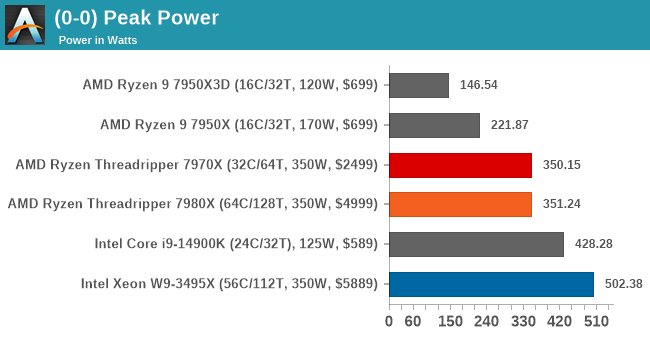
Looking at the max power we observed on the AMD Ryzen Threadripper 7980X and 7970X processors, we can see they hit and don't go robustly above their rated TDPs of 350 W. In contrast, the Intel Xeon W9-3495X peaked at a huge 502 W, well above the rated 350 W TDP. Compared to the desktop processors we've added to the data set, both Threadripper 7000 series processors are also considerably below the Intel Core i9-14900K.
Moving onto a deeper look at how the AMD Ryzen Threadripper 7980X compares to the Intel Xeon W9-3495X in Prime95 with Small FFTs, we can see that Intel's Sapphire Rapids WS option draws considerably more power. Despite having eight more cores than the W9-3495X, the Threadripper 7980X runs consistently within AMD's designated TDP of 350W; this is the TDP for all three AMD Ryzen Threadripper 7000 series SKUs. As we've highlighted in our desktop reviews of the Ryzen 9 7950X and Ryzen 9 7950X3D processors, we know AMD's Zen 4 core doesn't only deliver in performance, but it's a highly efficient core, too.
Compile/Database
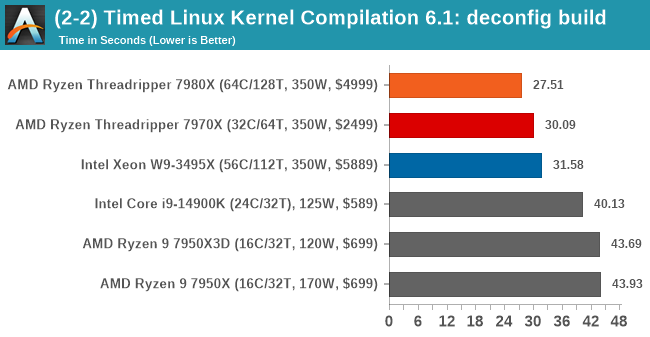
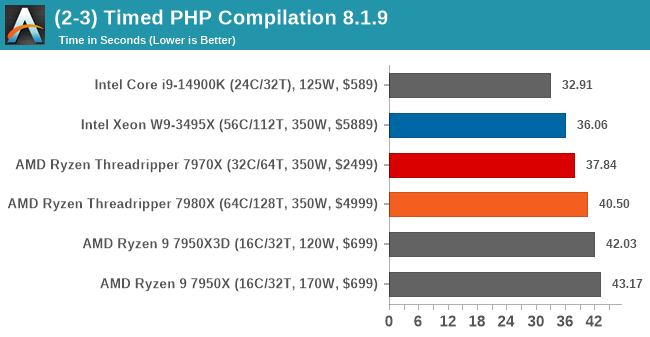
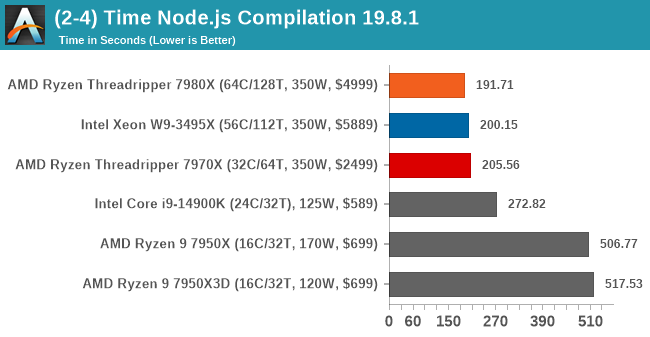
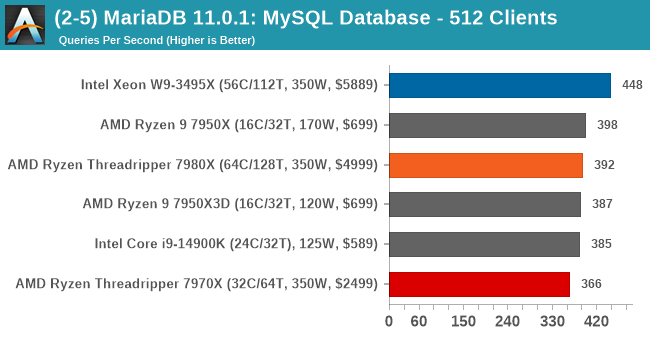
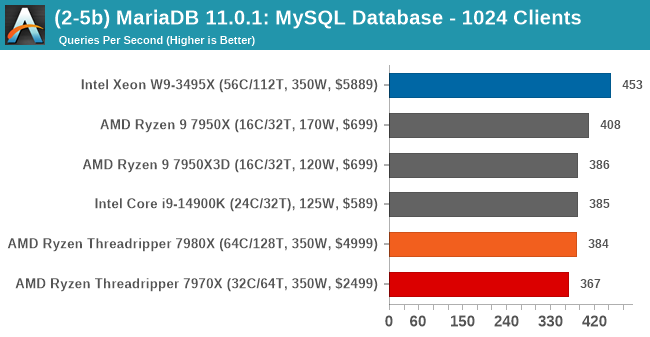
In our timed compilation benchmarks, including Linux Kernel, PHP, and Node.js, we can see that the Threadripper 7980X and 7970X perform well for the most part. In larger compilations such as Node.js, there's a significant advantage to having a higher core/thread count. Intel's Xeon W9-3495X beats all the chips we tested convincingly in the MariaDB MySQL database benchmark, with the flagship desktop chips also performing well here.


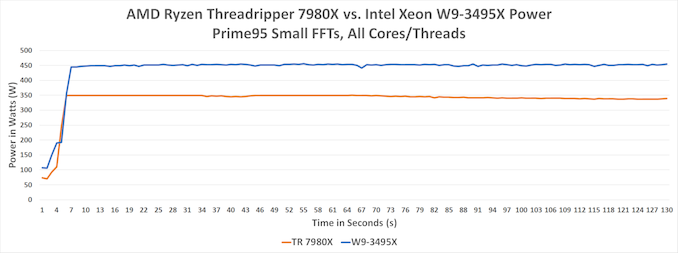








66 Comments
View All Comments
Makaveli - Monday, November 20, 2023 - link
So how did you not catch that the memory you were looking at was using Hynix?I just had to look at the specs and I knew just by the Cas latency. There was no good memory in the DDR4 range that came in at CL18.
meacupla - Tuesday, November 21, 2023 - link
Well, clearly, the site that I used thought it was B-die, when it was false info for the 2x16GB model.tamalero - Tuesday, December 5, 2023 - link
I remember when samsung released low quality "b" dies. It was in the news i think in tomshardware.These were used as "b dies" in corsair high end ram.
And they were not as good as the top class high binned true b die.
Someone correct me If I am wrong.
29a - Tuesday, November 21, 2023 - link
The PCB the memory is mounted on matters too.kn00tcn - Tuesday, November 21, 2023 - link
micron m-die(?) 3600c16 working great on am4, it just wasnt available until a couple years after launch, samsung isnt the only choiceand actually hynix had different dies, some tighter and more stable than others
first hand anecdotal:
1) in 2018 hynix cjr(?) 3200c16 / 2600x / msi b450m mortar = never fully stable, had to tweak low level ohms, maybe the cpu had issue, linux randomly showed amdgpu pcie timeouts in log
2) though in 2023 the same hynix sticks work fine with 5600g / asrock deskmeet
3) in 2020 micron 3600c16 / 3600x / asus tuf b450m = solid
4) in 2023 different micron 3600c16 / 5600 with pbo / same msi b450m mortar from 2018, everything fine
demu - Tuesday, November 21, 2023 - link
Before b-die memory I also had a G.Skill Trident set with Hynix ic:s (G.Skill 64GB (4 x 16GB) Trident Z, DDR4 3600MHz, CL17, 1.35V CL17-19-19-19).They also worked @3600 CL16-18-18-18 or 3733 CL17.
iamkyle - Monday, November 20, 2023 - link
I see unlike previous generations of Threadripper, AMD and its board partners are abandoning the "content creator/gamer" segment.Great for the workstation crowd, a loss for the aforementioned.
Threska - Monday, November 20, 2023 - link
The people who created Crysis could have used this. :-)kn00tcn - Tuesday, November 21, 2023 - link
and what does a content creator need tons of pcie lanes and quad+ channel memory for? regular desktop isnt weak with 16 high freq cores and 3d cacheif workloads like rendering scale so well with cores then they also scale across multiple networked computers for a cost effective render farm instead of a single expensive threadripper
main issue is probably the daw niche of extremely complex realtime audio synths/effects, but this has workarounds for years (prerender specific tracks), and it's not like we had better performance available in the past
thestryker - Monday, November 20, 2023 - link
HEDT isn't back when the platform price of entry is more than double that of the top desktop setups. AMD did release Zen 4 TR cheaper than Intel's current closest equivalent ($1500 vs $2100), but when $1500 is the cheapest it gets CPU wise you could put together CPU/DRAM/mobo for less. This is why I've contended TR 3xxx actually marked the end of HEDT as that is when the price of entry became significantly higher than desktop.